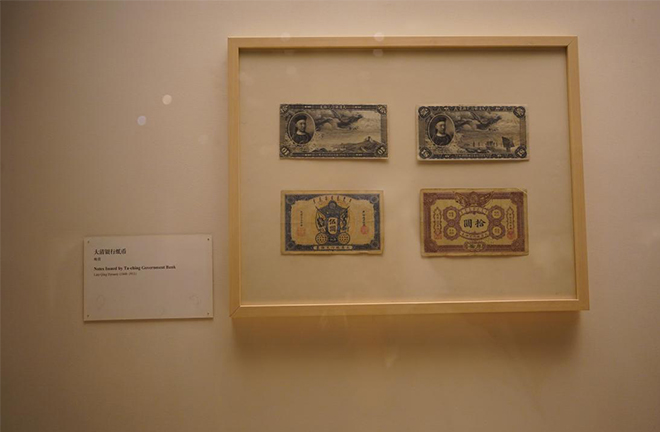Institute dedicated to Beijing’s historical culture

Notes issued by the Ta-ching Government Bank in the late Qing Dynasty at the National Museum of China in Beijing Photo: Yang Lanlan/CSST
Over 40 years of development, the Institute of History at the Beijing Academy of Social Sciences has formed a professional team dedicating to the study of Beijing’s historical and cultural heritage.
Development in different stages
The institute concentrates on the in-depth exploration of Beijing’s 3,000 years of history, including its status as a capital for over 800 years, and has produced landmark research results throughout its various stages of development.
In the early days of the institute, scholars focused primarily on collecting and compiling historical data related to Beijing, yielding The Data of Jicheng in Qin, Han, Wei, Jin, the Sixteen Kingdoms Period, and the Northern Dynasty, The History of Beijing in the Records of Qing Dynasty, and The Historical Data of Beijing Area in the War of Resistance Against Japanese Aggression. At the same time, the institute also conducted a preliminary discussion on Beijing’s history and culture, producing The Chronicles of Beijing, Ten Lectures on Ancient and Modern Beijing, and The Outline of the History of Beijing, and more, presenting the general context of Beijing’s historical development.
The General History of Beijing, published in 1994, is considered the most important work among the institute’s general history studies. It is divided into 10 volumes, tracing the historical evolution of Beijing from the pre-Qin era (prior to 221 BCE) to the founding of the People’s Republic of China in 1949, filling a void in the study of Beijing’s history.
Subsequently, the institute gradually transitioned into a phase of specialized research on the historical and cultural aspects of Beijing. A Collection of the Specific Histories of Beijing, which started in 2006, has so far published a series of over 10 bibliographies, conducting special analysis of the history of politics, institutional establishment and evolution, culture, literature, ethnicity, and customs. These publications have contributed to expanding the research scope of certain topics across different historical periods.
Over the years, the institute has gradually established its own distinctive features and expertise in various fields. It has achieved a wealth of fruitful results in the fields of historical geography, Qing (1644–1911) history, Manchu studies, palace etiquette culture, and folk customs and culture.
Since the 18th National Congress of the Communist Party of China, the institute has continued to delve into Beijing’s history and culture. In 2018, the first six volumes of The Urban History of Beijing were published under the chief editorship of Yin Junke, a research fellow at the institute. This series represents the first cross-sectional “portrait” of Beijing’s urban history from the perspectives of environment, transportation, organizational systems, and other aspects of the ancient capital, offering a reference for Beijing’s contemporary urban construction.
Construction of cultural center
In 2015, Beijing put forward the idea of overall protection of cultural heritage, focusing on the “three cultural belts” centered around the Great Wall, the Grand Canal, and the Western Hills. Following extensive research and investigation, the institute authored “The Proposal on Building the Yongding River Basin into the Fourth Cultural Belt in Beijing,” advocating for the establishment of the Yongding River cultural belt and its inclusion in the new Beijing urban plan, with the aim of establishing a more comprehensive and improved historical and cultural heritage protection system. Subsequently, the Western Hills cultural belt was officially designated as the Western Hills and the Yongding River cultural belt, providing a more standardized nomenclature for Beijing’s three cultural belts with more standardized names.
The Central Axis is the “backbone” of Beijing. In the context of the cultural value transformation along the Central Axis, Research Fellow Wang Gang proposed in his article “Recommendations for Creating a Street for Experiencing Old Beijing Folk Customs along the Southern Central Axis” to leverage the cultural value of the Central Axis as the foundation, organize traditional Beijing brands, and create more commercial activities to achieve better integration with social and economic development.
The institute has successively applied for several research projects with significant practical value, ranging from the exploitation and interpretation of the cultural resources of Beijing the ancient capital, the construction of the national cultural center through “one old city and three cultural belts,” the historical landscape of the Beijing section of the Grand Canal, the red historical and cultural resources of Beijing, and the literature on the historical and cultural blocks of the Central Axis. These have encouraged the institute to continuously expand new academic space while serving practical needs.
The institute is also committed to publicizing the historical and cultural connotations of the three cultural belts in forms of popular science books, lectures, TV programs, and more. It has long published relevant articles in Beijing Daily, Beijing Culture and History, Beijing Observation, and other newspapers and journals, combining academics, readability, and interest, displaying the cultural and historical features of Beijing.
In 2018, the institute undertook the task of writing “Beijing Cultural Books: The Series of Ancient Capital Culture.” Yan Chongnian, a famous cultural scholar and chief editor of the series, affirmed its value of enabling more people to know about Beijing’s long history and splendid culture. This not only represents academic innovation, but also embodies the effective transformation of cultural research results.
Edited by YANG LANLAN

 PRINT
PRINT CLOSE
CLOSE